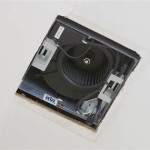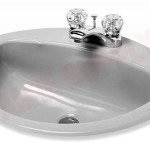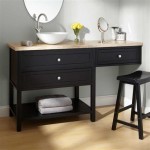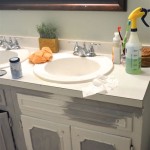Best Sealer for Bathroom Vanity
Bathroom vanities endure significant exposure to moisture, making them susceptible to water damage. A quality sealer provides a protective barrier, preventing water from penetrating the wood and causing warping, swelling, or mold growth. Selecting the appropriate sealer is crucial for preserving the vanity's appearance and extending its lifespan.
Key Considerations When Choosing a Sealer
Several factors influence the choice of the best sealer for a bathroom vanity. These include the vanity's material, the desired finish, and the level of water resistance required.
Different types of wood react differently to various sealers, so understanding the vanity's composition is essential. Some sealers are better suited for porous woods like oak, while others work best on denser woods like maple.
The desired aesthetic also plays a role in sealer selection. Some sealers enhance the wood's natural grain and offer a clear finish, while others provide a pigmented or painted look.
Finally, the level of water resistance needed depends on the vanity's location and usage. Vanities in high-moisture areas, such as near the shower, require a more robust sealer than those in less humid locations.
Types of Sealers for Bathroom Vanities
Various sealer types are available, each with unique properties and benefits.
Polyurethane: Known for its durability and water resistance, polyurethane forms a hard, protective film on the wood surface. It's available in both oil-based and water-based formulas. Oil-based polyurethane offers superior water resistance but has a strong odor and longer drying time. Water-based polyurethane is less odorous and dries faster, making it a popular choice for DIY projects.
Varnish: Similar to polyurethane, varnish provides a durable and water-resistant finish. It penetrates deeper into the wood, offering enhanced protection against scratches and stains. Varnish typically dries slower than polyurethane and may require thinning before application.
Lacquer: Lacquer offers a fast-drying, high-gloss finish. It's less durable than polyurethane or varnish and may not be suitable for high-moisture areas. Lacquer also requires specialized application techniques, often involving spraying.
Tung Oil: A natural oil finish, tung oil penetrates deep into the wood, providing excellent water resistance and enhancing the wood's natural beauty. It requires multiple coats and longer drying times compared to other sealers but offers a warm, rich finish.
Water-Based Sealers: These sealers are environmentally friendly and low in VOCs (volatile organic compounds). They dry quickly and are easy to clean up with water. While offering good protection against moisture, they may not be as durable as oil-based sealers.
Application Techniques
Proper application is crucial for maximizing the sealer's effectiveness. Surfaces must be clean, dry, and free of dust and debris before applying any sealer.
Application methods vary depending on the type of sealer. Some sealers can be applied with a brush, while others require spraying. Following the manufacturer's instructions regarding application techniques, drying times, and number of coats is essential for achieving optimal results.
Sanding between coats can enhance the final finish and ensure a smooth, even surface. Proper ventilation is also important when working with sealers, especially those with strong odors.
Maintaining Sealed Bathroom Vanities
Regular maintenance can prolong the life of the sealer and protect the vanity. Cleaning the vanity with a mild soap and water solution regularly can help prevent the buildup of dirt and grime that can damage the sealer.
Avoid using harsh chemicals or abrasive cleaners, as these can damage the finish. Placing coasters under glasses and wiping up spills promptly can also help prevent water damage.
Reapplying the sealer periodically is necessary to maintain its protective qualities. The frequency of reapplication depends on the type of sealer used, the vanity's usage, and the level of moisture exposure. Inspecting the sealer regularly for signs of wear and tear can help determine when reapplication is needed.
Choosing the Right Sealer for Different Wood Types
Different wood species have unique characteristics that influence sealer selection.
Porous Woods (Oak, Ash): These woods readily absorb sealers, requiring multiple coats for adequate protection. Oil-based sealers penetrate deep into the pores, providing excellent water resistance.
Dense Woods (Maple, Cherry): These woods require fewer coats of sealer. Water-based sealers work well on dense woods, offering good protection without altering the wood's natural color.
Environmental Considerations
When choosing a sealer, consider its environmental impact. Water-based sealers are generally considered more environmentally friendly than oil-based sealers due to their lower VOC content. Look for sealers with low VOC emissions to minimize indoor air pollution.
Proper disposal of used sealer containers and materials is also important for protecting the environment. Follow local regulations regarding the disposal of hazardous waste.
Cost Considerations
Sealers vary in price depending on the type, brand, and quantity. While cost is a factor, it shouldn't be the sole determinant. Investing in a high-quality sealer can save money in the long run by preventing costly repairs or replacements due to water damage.

Finish For A Bathroom Vanity The Wood Whisperer

How To Seal Vanity Top Storables

How To Build Protect A Wood Vanity Top Houseful Of Handmade
What Are The Best Materials For Bathroom Vanity Countertops Toulmin Kitchen Bath Custom Cabinets Kitchens And Design Remodeling In Tuscaloosa Birmingham Alabama

Should You Caulk Around A Bathroom Vanity Bathtubber

What Are The Best Materials For Bathroom Vanity Countertops Toulmin Kitchen Bath Custom Cabinets Kitchens And Design Remodeling In Tuscaloosa Birmingham Alabama

How To Refinish Bathroom Vanity Top With Diy Resin Thediyplan

How To Finish A Wood Bathroom Countertop And Vanity South House Designs
Bathroom Vanity Top Guide Signature Hardware

How To Paint Cabinets Last Painting A Bathroom Vanity Maison De Pax
Related Posts







